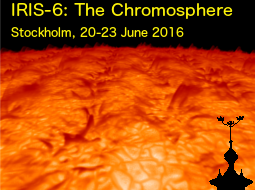Speaker
Marina Battaglia
(University of Applied Sciences Northwestern Switzerland)
Description
In the common flare scenario beams of accelerated electrons deposit large amounts of
energy into the chromosphere, heating it to MK temperatures and causing
chromospheric evaporation, i.e. the expansion of the heated plasma into the magnetic
loop. What is the importance of energy deposition by electron beams in driving
evaporation relative to other types of energy deposition such as by thermal
conduction? We present simultaneous EUV and X-ray observations of chromospheric
evaporation in the flare SOL2014-03-29T17:48. IRIS observations of the FeXXI line
indicate evaporating plasma at a temperature of 10 MK along the flare ribbon during
the flare peak and several minutes into the decay phase. Hard X-ray footpoints are
observed for two minutes during the peak of the flare. Their locations coincide with
the locations of the upflows in parts of the southern flare ribbon consistent with a
scenario of beam driven chromospheric evaporation. However, in other parts of the
southern ribbon and in the northern ribbon the observed upflows are not coincident
with a HXR source in time nor space, most prominently during the decay phase. In this
case evaporation is likely triggered due to energy input by a conductive flux that is
established between the hot (25 MK) coronal source, which is present during the whole
observed time-interval, and the chromosphere. These observations suggest that
conduction driven evaporation dominates not only during the decay phase but also
during the flare peak.
Primary author
Marina Battaglia
(University of Applied Sciences Northwestern Switzerland)

